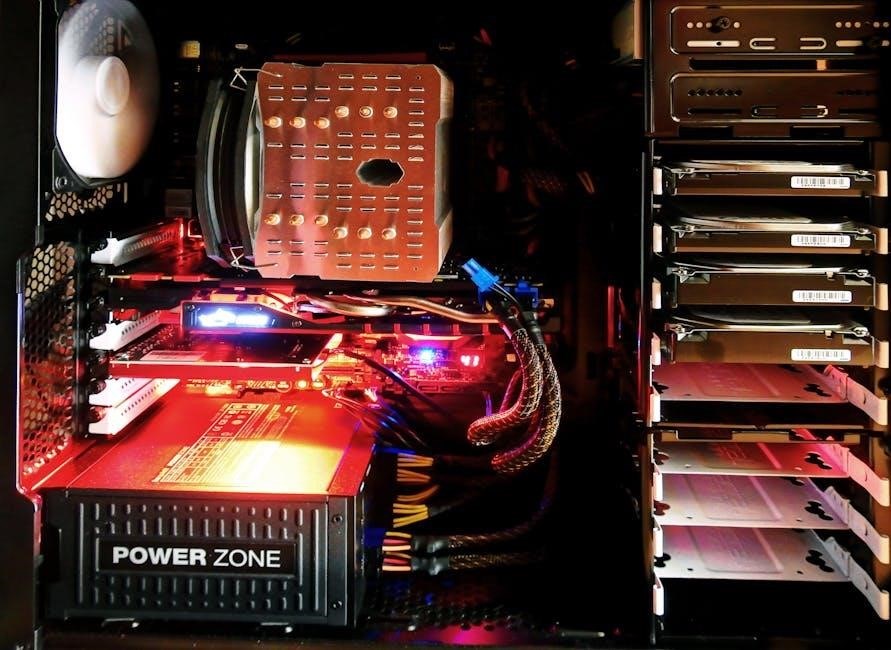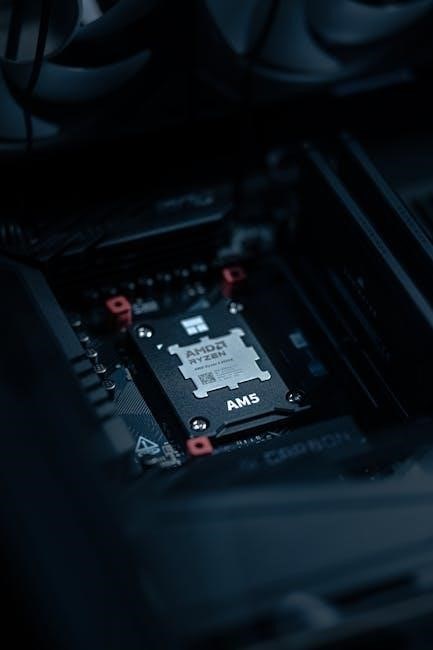
Discover how Power Automate Desktop empowers users to automate tasks‚ bridging the gap between technical experts and non-technical users‚ making RPA accessible to everyone.
What is RPA and Its Importance in Modern Automation
Robotic Process Automation (RPA) is a technology that enables organizations to automate repetitive‚ rule-based tasks by mimicking human actions across various applications. It is a cornerstone of modern automation‚ allowing businesses to streamline workflows‚ reduce manual errors‚ and improve operational efficiency. RPA is particularly valued for its ability to integrate with existing systems‚ bridging gaps between legacy applications and modern platforms. By automating tasks‚ RPA empowers businesses to save time‚ lower costs‚ and focus on strategic initiatives. Its importance lies in its scalability and adaptability‚ making it a critical tool for industries seeking to enhance productivity and remain competitive in a rapidly evolving digital landscape.
Understanding Power Automate Desktop and Its Role in RPA
Power Automate Desktop is a powerful tool designed to simplify robotic process automation (RPA) by enabling users to create and automate workflows directly on their desktops. It offers a user-friendly interface for recording and editing UI flows‚ allowing users to automate repetitive tasks across various applications. With features like debugging tools and error handling‚ it ensures robust automation processes. Power Automate Desktop plays a pivotal role in RPA by making automation accessible to both technical and non-technical users. Its ability to integrate with everyday tools and applications empowers organizations to streamline operations‚ enhance productivity‚ and reduce manual work. This tool is central to Microsoft’s vision of democratizing RPA‚ ensuring it is scalable and adaptable for diverse organizational needs.
Overview of the Book “Democratizing RPA with Power Automate Desktop”
Democratizing RPA with Power Automate Desktop is a comprehensive guide authored by Peter Krause and published by Packt Publishing Ltd. Released in April 2023‚ this 308-page book is designed to empower users of all skill levels to master robotic process automation (RPA) using Power Automate Desktop. The book provides a detailed introduction to RPA concepts‚ step-by-step guidance on creating and modifying UI flows‚ and practical advice on debugging and error handling. It also explores real-world applications of RPA‚ highlighting how desktop flows can integrate with everyday tools to automate tasks and boost productivity. Written in an engaging and accessible style‚ the book caters to both beginners and experienced automation enthusiasts‚ making it an essential resource for anyone looking to leverage Power Automate Desktop for streamlining workflows.

Key Concepts and Features of Power Automate Desktop
Power Automate Desktop enables task automation through UI flows‚ debugging‚ and error handling‚ making RPA accessible while integrating seamlessly with everyday tools for enhanced productivity.
UI Flows: Creation and Modification
Creating and modifying UI flows in Power Automate Desktop is straightforward‚ allowing users to record and automate tasks across applications. The intuitive interface enables easy editing of flow steps‚ adding conditions‚ and incorporating data extraction. Users can leverage pre-built actions or create custom ones to tailor workflows to specific needs. The Process Automation Designer (PAD) provides advanced features for refining flows‚ ensuring robust automation. By simplifying the creation process‚ Power Automate Desktop democratizes RPA‚ making it accessible to both novice and experienced users. This accessibility fosters efficiency and innovation‚ driving productivity across industries and teams.
Debugging and Error Handling in Power Automate Desktop
Debugging and error handling in Power Automate Desktop are essential for ensuring robust automation workflows. The platform offers tools like breakpoints and step-by-step execution to identify and resolve issues efficiently. Users can leverage error handling actions‚ such as On Error or Retry‚ to manage unexpected failures gracefully. These features empower users to create reliable automations without extensive technical expertise. By simplifying debugging‚ Power Automate Desktop democratizes RPA‚ enabling even non-technical users to maintain and troubleshoot their workflows effectively. This accessibility ensures higher productivity and reduces downtime‚ making automation more approachable and sustainable for organizations of all sizes.
Process Automation Designer (PAD) is a powerful tool within Power Automate Desktop that simplifies the creation and management of automation workflows. It provides an intuitive interface for designing flows‚ allowing users to visually map out processes and implement logic without coding. PAD supports advanced features like conditional logic‚ loops‚ and error handling‚ making it versatile for complex automation tasks. Its user-friendly design democratizes RPA by enabling both novice and experienced users to build robust automations. By leveraging PAD‚ organizations can streamline repetitive tasks and enhance productivity‚ aligning with Microsoft’s vision of making automation accessible to everyone.

Democratizing RPA: Making Automation Accessible
Power Automate Desktop empowers users of all skill levels to automate tasks‚ fostering a culture where automation is accessible‚ intuitive‚ and inclusive for everyone‚ driving efficiency and innovation.
Microsoft’s Vision for Democratizing RPA
Microsoft’s vision for democratizing RPA centers on making automation accessible to everyone. By leveraging Power Automate Desktop‚ the company aims to empower users of all skill levels to streamline repetitive tasks. This vision aligns with Microsoft’s broader goal of fostering a culture of citizen developers‚ where non-technical users can create and implement automation solutions without extensive coding knowledge. Through intuitive tools and user-friendly interfaces‚ Microsoft seeks to break down barriers‚ enabling organizations to adopt RPA more widely and efficiently. This approach not only enhances productivity but also promotes innovation across industries‚ ensuring that automation benefits are realized by a broader audience.
Empowering Users with No-Code Automation Tools
Empowering users with no-code automation tools is a cornerstone of democratizing RPA. Power Automate Desktop enables individuals‚ regardless of their technical expertise‚ to create and manage automation workflows seamlessly. By providing an intuitive‚ visual interface‚ the platform allows users to design flows that automate repetitive tasks‚ such as data entry or document processing‚ without writing a single line of code. This accessibility fosters a culture of citizen developers‚ where employees across all levels can contribute to process improvement. With features like UI flows and the Process Automation Designer‚ users can easily interact with desktop applications and integrate automation into their daily tasks‚ driving productivity and innovation across organizations.

Real-World Applications of Democratized RPA
Democratized RPA enables organizations to automate everyday tasks across various industries‚ enhancing efficiency and reducing manual effort. In healthcare‚ RPA can automate patient data entry and appointment scheduling‚ improving accuracy and patient care. Finance departments can benefit from automated invoice processing and expense tracking‚ reducing errors and speeding up financial workflows. Retail businesses can use RPA to manage inventory updates and order processing‚ ensuring seamless operations. By integrating with tools like Microsoft Office and SAP‚ Power Automate Desktop allows users to automate interactions between applications‚ generating reports or updating records without manual intervention. These real-world applications demonstrate how democratized RPA empowers organizations to streamline processes‚ save time‚ and allocate resources more effectively‚ driving productivity and innovation across industries.

Technical Aspects of Power Automate Desktop
Power Automate Desktop simplifies RPA by offering tools to record‚ automate‚ and manage workflows‚ enabling seamless integration with everyday applications and enhancing productivity through intelligent automation.
Getting Started with Desktop Flows
Getting started with desktop flows in Power Automate Desktop is designed to be intuitive‚ enabling users to quickly begin automating tasks. Start by installing Power Automate Desktop and launching the Process Automation Designer (PAD). Create a new project and explore the interface‚ which offers tools for recording actions‚ editing workflows‚ and managing inputs. Use the recorder to capture mouse and keyboard actions‚ generating a flow that mimics your interactions. Learn to add steps manually‚ such as launching applications or interacting with web pages. Experiment with built-in actions to enhance your flow. Debugging features help identify and fix issues. Completing these steps equips you to build and refine automations‚ laying the groundwork for more complex workflows. This ease of use democratizes automation‚ making it accessible to everyone‚ regardless of technical expertise.
Best Practices for Automating Repetitive Tasks
When automating repetitive tasks using Power Automate Desktop‚ follow best practices to ensure efficiency and reliability. Start by identifying tasks that are repetitive‚ time-consuming‚ and prone to human error‚ as these are ideal candidates for automation. Simplify workflows by breaking them into smaller‚ manageable steps. Use UI flows to interact with applications and websites seamlessly. Implement error handling and debugging mechanisms to address potential issues. Test your flows thoroughly before deploying them in production environments. Regularly review and optimize automations to adapt to changing processes. By adhering to these practices‚ you can maximize productivity‚ reduce errors‚ and maintain high-quality outcomes. This approach empowers users to create robust automations that align with organizational goals;
Integrating Power Automate Desktop with Everyday Tools
Power Automate Desktop seamlessly integrates with everyday tools and applications‚ enabling users to automate tasks across multiple platforms. It supports interactions with Microsoft Office‚ web browsers‚ SAP‚ and other desktop applications‚ allowing for end-to-end automation. By connecting these tools‚ users can streamline workflows‚ reduce manual effort‚ and enhance productivity. The platform’s compatibility with Windows‚ Mac‚ and Linux ensures versatility for diverse environments. Additionally‚ Power Automate Desktop’s ability to work with various software tools makes it a powerful solution for automating repetitive tasks. This integration capability is a key factor in democratizing RPA‚ making automation accessible to everyone. The book provides detailed guidance on how to leverage these integrations effectively.

Advanced Topics in RPA with Power Automate Desktop
Explore advanced RPA techniques using Power Automate Desktop‚ including AI integration‚ complex flow management‚ and robust security measures to enhance automation capabilities and ensure secure processes.
Using AI to Enhance Automation Workflows
AI integration with Power Automate Desktop revolutionizes automation by enabling intelligent decision-making. Users can leverage AI-driven tools to analyze data‚ predict outcomes‚ and optimize workflows‚ reducing manual intervention. By incorporating machine learning models‚ processes like document processing‚ data extraction‚ and task prioritization become more efficient. AI also enhances error handling by predicting and mitigating issues before they occur. This seamless fusion of AI and RPA empowers organizations to create smarter‚ adaptive automation solutions‚ driving productivity and innovation across industries. With AI‚ Power Automate Desktop ensures that workflows are not only automated but also continuously improved‚ making automation accessible and powerful for all users.
Advanced Flow Creation and Management
Advanced flow creation in Power Automate Desktop enables users to design sophisticated automation processes. By leveraging visual interfaces and drag-and-drop functionalities‚ even non-technical users can craft complex workflows. Management features allow for version control‚ collaboration‚ and detailed analytics‚ ensuring transparency and efficiency. With the ability to integrate AI and machine learning‚ flows can adapt to dynamic environments‚ enhancing decision-making capabilities. Additionally‚ advanced error handling and debugging tools empower users to identify and resolve issues swiftly. This comprehensive approach to flow management democratizes RPA‚ making it accessible while maintaining scalability and reliability for organizations of all sizes.
Ensuring Security and Compliance in RPA Processes
Security and compliance are paramount in RPA implementations. Power Automate Desktop incorporates robust measures to safeguard sensitive data‚ including encryption and secure authentication protocols. Role-based access ensures only authorized users can modify or execute flows‚ preventing unauthorized breaches. Compliance with industry standards like GDPR and HIPAA is maintained through audit trails and detailed logging. Automated workflows are designed to adhere to organizational policies‚ minimizing risks of non-compliance. Regular updates and patches further enhance security‚ ensuring RPA processes remain protected against evolving threats. This focus on security and compliance makes Power Automate Desktop a reliable choice for enterprises aiming to democratize automation responsibly.

Case Studies and Success Stories
Organizations worldwide have successfully implemented Power Automate Desktop‚ achieving significant productivity gains. Industries like healthcare and finance report streamlined workflows‚ with automation reducing manual tasks by up to 70%.
How Organizations Have Benefited from Power Automate Desktop
Organizations have significantly boosted productivity by automating repetitive tasks with Power Automate Desktop. Industries like healthcare‚ finance‚ and retail have streamlined operations‚ reducing manual effort and errors. Companies report faster task completion‚ improved accuracy‚ and enhanced employee satisfaction. Small and medium-sized enterprises (SMEs) have benefited by reducing operational costs‚ while large corporations have scaled automation across departments. For instance‚ automating patient record updates in healthcare or financial data entry has saved countless hours. These successes highlight how democratizing RPA empowers organizations to focus on strategic initiatives‚ driving innovation and growth. Real-world applications demonstrate the transformative impact of Power Automate Desktop in modern workflows.
Implementing RPA in Different Industries
Power Automate Desktop has revolutionized industries by enabling efficient automation across diverse sectors. Healthcare organizations leverage it for patient record management and billing processes‚ while financial institutions automate transaction reconciliation and compliance checks. Retail businesses streamline inventory management and customer service workflows. Manufacturing companies use it to optimize supply chain operations and production scheduling. Government agencies adopt RPA for automating public service requests and data management. The versatility of Power Automate Desktop allows it to adapt to industry-specific needs‚ empowering organizations to achieve operational efficiency. By democratizing RPA‚ businesses across industries can now access advanced automation tools‚ driving innovation and productivity. This widespread adoption underscores its universal applicability and transformative potential.
Measuring Productivity Gains Through Automation
Power Automate Desktop enables organizations to quantify productivity gains by automating repetitive tasks‚ reducing manual effort‚ and streamlining workflows. By implementing RPA‚ businesses can measure significant reductions in task completion times‚ minimized errors‚ and improved resource utilization. Automation tools provide clear metrics‚ such as cycle times‚ throughput‚ and cost savings‚ allowing organizations to assess the impact of RPA initiatives. Additionally‚ automation bridges the gap between technical and non-technical users‚ fostering collaboration and efficiency. With Power Automate Desktop‚ companies can track productivity improvements in real-time‚ ensuring continuous optimization. This transparency empowers organizations to refine processes further‚ amplifying the benefits of democratized RPA across industries.

Future of RPA and Power Automate Desktop
The future of RPA lies in AI-driven workflow enhancements‚ empowering users with intuitive tools. Power Automate Desktop will continue to democratize automation‚ making it faster and more accessible.
Trends in Automation and RPA

Automation and RPA are rapidly evolving‚ with a growing emphasis on no-code platforms that empower non-technical users. Power Automate Desktop exemplifies this trend‚ offering intuitive tools for task automation. AI integration is reshaping workflows‚ enabling smarter decision-making and process optimization. Companies are adopting RPA to streamline operations‚ reduce manual effort‚ and enhance productivity. The democratization of RPA ensures that automation is no longer limited to IT experts but is accessible to all. These advancements are driving innovation across industries‚ fostering efficiency and agility. As AI and machine learning continue to advance‚ RPA tools like Power Automate Desktop will play a pivotal role in shaping the future of work.
Evolution of Power Automate Desktop
Power Automate Desktop has undergone significant evolution‚ enhancing its capabilities to meet the growing demands of automation. Initially focused on simplifying task automation‚ it now integrates advanced features like AI-driven workflows and seamless integration with everyday tools. Microsoft continues to expand its functionality‚ ensuring it remains user-friendly while catering to both beginners and experts. The platform’s evolution emphasizes democratizing RPA‚ enabling non-technical users to create and manage workflows effortlessly. Regular updates and improvements reflect its commitment to staying at the forefront of automation technology‚ making it a versatile tool for personal and professional productivity. This continuous development ensures Power Automate Desktop remains a leader in the RPA space.
The Role of AI in Future RPA Developments
AI plays a pivotal role in shaping the future of RPA‚ enhancing automation capabilities and driving efficiency. By integrating machine learning algorithms‚ Power Automate Desktop can predict user needs‚ automate complex workflows‚ and improve decision-making. AI-powered tools enable smarter process automation‚ reducing manual intervention and minimizing errors. Advanced AI features‚ such as natural language processing and intelligent process discovery‚ are expected to further streamline RPA development. These innovations ensure that users can create and manage workflows with greater ease‚ making automation accessible to everyone. As AI continues to evolve‚ it will be instrumental in advancing the democratization of RPA‚ empowering users across industries to achieve unprecedented productivity levels.
Summarizes key insights from democratizing RPA‚ empowering users through automation‚ and provides resources for further learning‚ including access to the PDF and community support.
Summarizing the Key Takeaways

Accessing the “Democratizing RPA with Power Automate Desktop” PDF
The Democratizing RPA with Power Automate Desktop PDF is readily available for download‚ offering a convenient way to access the book’s content. Readers can purchase the print or Kindle version‚ which includes a free PDF download. Additionally‚ the eBook can be accessed through platforms like PacktLib or O’Reilly‚ providing flexible options for learners. The PDF is also available for free download from various online repositories‚ making it easily accessible to a broad audience. This ensures that users can leverage the book’s insights on RPA and Power Automate Desktop anytime‚ anywhere‚ enhancing their automation skills efficiently.
Further Learning and Community Resources
For deeper exploration‚ the Democratizing RPA with Power Automate Desktop PDF is complemented by additional resources. Packt Publishing offers a dedicated page with links to code repositories and author insights. O’Reilly provides a 10-day free trial for access to the book and other titles. Microsoft forums and LinkedIn groups dedicated to Power Automate Desktop foster community engagement‚ where users share tips and solutions. Webinars and workshops hosted by industry experts further enhance learning. Additionally‚ YouTube channels and blogs focused on RPA and automation provide hands-on tutorials and real-world examples‚ ensuring continuous growth in mastering Power Automate Desktop. These resources collectively empower users to advance their automation skills effectively.
